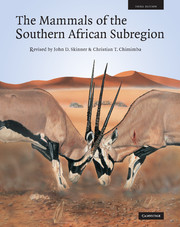Book contents
- Frontmatter
- Contents
- Editorial board
- Acknowledgements
- Foreword
- Preface
- The Mammal Research Institute
- R. H. N. Smithers
- Explanatory notes
- SUPERCOHORT AFROTHERIA
- COHORT PAENUNGULATA
- SUPERCOHORT EUARCHONTAGLIRES COHORT GLIRES
- COHORT EUARCHONTA
- Order PRIMATES
- SUPERCOHORT LAURASIATHERIA
- COHORT FERUNGULATA
- Bibliography
- Appendix 1 Conservation status of southern African mammals
- Appendix 2 Colloquial names
- Index of scientific names
- Index of English colloquial names
- List of subscribers
- Plate Section
- Plate Section
- Plate Section
- Plate Section
- Plate Section
- Plate Section
- Plate Section
Order PRIMATES
from COHORT EUARCHONTA
Published online by Cambridge University Press: 05 July 2013
- Frontmatter
- Contents
- Editorial board
- Acknowledgements
- Foreword
- Preface
- The Mammal Research Institute
- R. H. N. Smithers
- Explanatory notes
- SUPERCOHORT AFROTHERIA
- COHORT PAENUNGULATA
- SUPERCOHORT EUARCHONTAGLIRES COHORT GLIRES
- COHORT EUARCHONTA
- Order PRIMATES
- SUPERCOHORT LAURASIATHERIA
- COHORT FERUNGULATA
- Bibliography
- Appendix 1 Conservation status of southern African mammals
- Appendix 2 Colloquial names
- Index of scientific names
- Index of English colloquial names
- List of subscribers
- Plate Section
- Plate Section
- Plate Section
- Plate Section
- Plate Section
- Plate Section
- Plate Section
Summary
THE SEARCH FOR, and the study of, the fossil evidence of primate evolution and the emergence of modern man (Homo sapiens), which has occupied palaeontologists for over 150 years, is a fascinating story but one that is beyond the scope of this book. It begins with a small primitive primate named Purgatorius unio Van Valen & Sloan, 1965 (Suborder Plesiadapiformes) that lived 65 Mya (Szalay & Delson, 1979) in what is now western North America. The abundant fossil remains of this species recovered from Late Cretaceous to Early Palaeocene deposits show that they were rat–sized. The inclusion of P. unio in the Order Primates is controversial, some authors (e.g. Cartmill, 1972; Martin, 1972) advocating the exclusion of the arboreal Plesiadapiformes from the primates.
In the case of the Hominidae, the identification of the primitive hominid Australopithecus africanus by Dart (1925a, 1925b) from a skull found in the Buxton limeworks near Taung in the North West Province, stimulated the search for hominid material, placing South Africa at the forefront in this field. The identification of hominid material is widely debated and the origin of Homo sapiens sapiens remains uncertain, although it is likely that modern man arose in sub–Saharan Africa (Szalay & Delson, 1979).
The higher classification to families adopted here follows that used by Groves (2001) and Bronner et al. (2003), who, following Szalay & Delson (1979), placed the living members of this order in the suborders Strepsirhini and Haplorhini. Groves (2001) lists 13 families worldwide in the order, comprising some 60 genera and 233 species.
- Type
- Chapter
- Information
- The Mammals of the Southern African Sub-region , pp. 210 - 230Publisher: Cambridge University PressPrint publication year: 2005



